Pepsi Max
Pepsi Max (also known as Pepsi Black in some countries) is a low-calorie, sugar-free cola, marketed by PepsiCo as an alternative to Pepsi and Diet Pepsi. Pepsi Max is available primarily in Asian and European markets. While Pepsi Max was released on April 5, 1993, it was first available on store shelves in the United States in 2007.
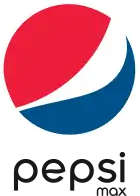 | |
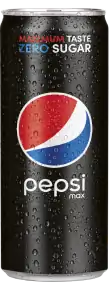 330ml can of Pepsi Max | |
| Product type | Diet cola |
|---|---|
| Owner | PepsiCo |
| Country | International |
| Introduced | April 5, 1993 |
| Related brands | Pepsi ONE, Diet Pepsi |
| Tagline | "Maximum Taste, No Sugar" |
A drink with the same name but different formulation (containing ginseng and higher quantities of caffeine) was sold in the United States until it was renamed "Pepsi Zero Sugar" in late 2016.
History

Pepsi Max debuted in Australia, the United Kingdom, and Italy on April 5, 1993. The rollout was expanded to Ireland the following September, and to France, Greece, Spain, Portugal, and the Netherlands the following December. By the end of 1994, Pepsi Max was sold in approximately twenty countries. By the end of 1995, that figure had more than doubled. The product remained unavailable in the United States until 2006 (the US, PepsiCo's home market, and the largest consumer of carbonated soft drinks), where one of its principal ingredients had not yet been approved by the Food and Drug Administration. The ingredient—acesulfame potassium—is combined with aspartame to provide the beverage's sweetness, whereas some other diet colas are sweetened by aspartame alone.
In early-2005, Pepsi Max Twist (with added lemon-lime flavour) joined the UK and Australian product line. In autumn 2005, "Pepsi Max Punch" was marketed in the UK for the festive season. Containing ginger and cinnamon, the product was similar in flavour to Pepsi Holiday Spice, a sugar-sweetened variety of Pepsi that was marketed in the US one year earlier. In late-2005 and early-2006, a coffee-flavoured variety was introduced in France, Finland, Ireland, Norway, and the UK. Known as "Pepsi Max Cappuccino" ("Pepsi Max Coffee Cino" in the UK), the product was prefigured by the similar Pepsi Kona (briefly test-marketed in the US in 1996) and Pepsi Tarik, available in Malaysia since 2005.
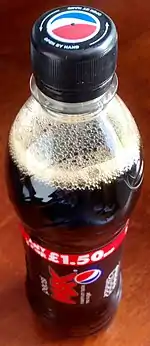
Pepsi Max was introduced to South Korea, Bulgaria, and the Philippines in 2006, as well as being reintroduced into Argentina in the spring of 2006 after being phased out after its launch in 1994. As well as this, Pepsi Max was introduced into Brazil, Egypt, Jordan, Lebanon, Turkey and the United Arab Emirates during early 2007.
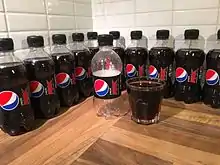
In October 2008, Pepsi announced it would be redesigning its logo and re-branding many of its products. Pepsi, Diet Pepsi, and Pepsi Max all use lower-case fonts for name brands, Mountain Dew was renamed "Mtn Dew", and Diet Pepsi Max was re-branded as Pepsi Max. The brand's blue and red globe trademark became a series of "smiles", with the central white band arcing at different angles depending on the product. The new imagery is being used. In the case of Pepsi Max, besides renaming of the drink its international name, the logo has a large "smile" likely to emphasize the North American drink's "Wake up people!" advertising campaign, and also uses black in the bottom half of the globe as opposed to the more standard royal blue. The new lower-case font used on Pepsi's products is reminiscent of the font used in Diet Pepsi's logo from the 1960s to the mid-1980s. The website for the "Wake up people!" campaign now redirects to the Pepsi Refresh Project. It is expected that the version of Pepsi Max outside North America will adopt the new logo used by its US–Canada counterpart; this has now occurred in Australia. In the UK, the cans now have the "Pepsi" text and the new Pepsi globe (with the normal Pepsi "smile" and the blue bottom half, as opposed to the black half used in the US) but the "Max" is in the previous style.
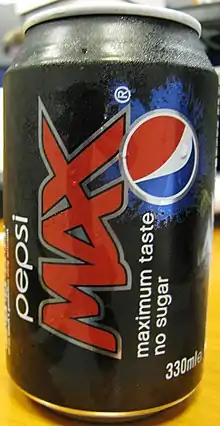
A Pepsi Max Lime version was released in the United States in February 2010 under the name "Pepsi Max Cease Fire" It was introduced in the UK in late-2011. It was cross-promoted with a new flavor series of Doritos chips called "3rd Degree Burn". In July 2010, Pepsi began to move its North American branding for Pepsi Max to match its global branding. It now carries a Max typography similar to that used worldwide, and rolled out a new slogan: "Zero Calories. Maximum Pepsi Taste". Its formula has not changed. In May 2011, Pepsi introduced the drink to Spain. In 2016, the drink was introduced to Venezuela. In 2017 Pepsi Max was launched in Costa Rica.[1]
In 2013, Pepsi Max collaborated with English magician Steven Frayne, also known as Dynamo, as part of their 'Live for Now' campaign which was launched the previous year. As part of a launch event, Dynamo was seen in London hanging from the side of a number 543 double-decker bus on its journey along Millbank, past the Houses of Parliament and across Westminster Bridge, while hundreds of passers by watched.[2][3] The partnership also saw Dynamo appear in an on-pack promotion on cans and bottles of Pepsi Max during July and August, and secured 19 million unique impressions and 7 million total video views on social media.[4]
In 2017, the drink was reintroduced in Belarus, the Czech Republic, Greece, Hungary, India, Slovakia, Slovenia and Ukraine as Pepsi Black. As of 2017 it is available as Pepsi Max in Albania, Australia, Austria, Belgium, Bosnia and Herzegovina, China, Croatia, Denmark, Estonia, Finland, France, Germany, Italy, Iceland, Ireland, Liechtenstein, Luxembourg, Macedonia, Moldova, Montenegro, the Netherlands, New Zealand, Norway, the Philippines, Poland, Portugal, Romania, Russia, Serbia, Spain, Sweden, Switzerland, Thailand, Turkey, the United Kingdom and Venezuela.
Product positioning
Recent UK/Australia Pepsi Max television advertisements (as well as in several European countries) have featured the taglines "Maximum taste, no sugar" and "Don't worry, there's no sugar." Some have incorporated extreme sports, as well as video games such as Motocross Mania in an attempt to appeal to young men (in contrast to other diet cola drinks, which tend to target young women). The British advertising campaign involved retouched versions of the American "Do the Dew" commercials for Mountain Dew (A variant of which is sold in the UK), rebranded as "Live life to the Max".
Coca-Cola Zero, a sugar-free cola from The Coca-Cola Company, is marketed in a similar manner. In the UK, some Coke Zero advertising alluded to Pepsi Max, leading to a counter-campaign by Pepsi extolling the virtues of the concept of "maximum" over that of "zero".[5][6][7]
Variants
| Name | Definition |
|---|---|
| Lemon and Lime Twist | Pepsi Max with a lemon and lime flavor. It was sold in the United Kingdom and Argentina for a time and was sold in France under the name Pepsi Max Citron Citron Vert. Pepsi Twist with lemon was also available in Norway in the early 2000s, and is currently available in Brazil, Poland and Turkey. |
| Lime | Pepsi Max with a lime flavor. Currently available in Lebanon, Denmark, Finland, Sweden, Norway, Iceland, Hungary, Romania, Poland, Serbia, Czech Republic, United Kingdom, China and Portugal. |
| Cease Fire | Pepsi Max with a lime flavor. Sold in North America during 2010, and Australia in 2011 which was cross-promoted with limited edition Degree Burn flavors of Doritos. It was later sold in the UK as Pepsi Max Citrus Freeze in 2011, being promoted with Jalapeño Fire Doritos as a part of a promotion. It was later re-released as a permanent flavor in Australia as Pepsi Max Lime, and was later released in France under the same name. |
| Punch | Pepsi Max with a ginger and cinnamon flavor. It was sold in the UK during Christmas 2005 and is similar to the North American Pepsi Holiday Spice which was sold the year before and the year after. |
| Coffee Cino | Pepsi Max with a coffee flavor. It was sold for a short time in some European countries. |
| Lemon | Pepsi Max with a lemon flavor. It is currently being sold in The Netherlands and Belgium, and in Australia 2022. As of 2023 it is also being sold in the Nordics. |
| Chill | Pepsi Max with an apple flavor. It was sold in Sweden and Finland as a limited edition in the summer of 2007. |
| Mojo | Pepsi Max with a mint and lime flavor. It was sold in Finland as a limited edition in 2008 and was also sold in Denmark until August 2009 under the name Pepsi Max Mojito. |
| Cherry | Pepsi Max with a cherry flavor. It was first sold in the UK in 2011 and has since become available in Germany, Norway, Denmark, Finland, France and the Netherlands. It was also released as Pepsi Max Cherry Blast in the United States in 2015. |
| Ginger | Pepsi Max with ginger flavor. Released in the UK, Lebanon, Norway, Sweden, Finland, Germany, Denmark, and the Netherlands in 2017. |
| Vanilla | Pepsi Max with a vanilla flavor. It was first sold in Australia in 2017, in New Zealand in 2018 and in Poland and Germany during 2018 and 2019. |
| Raspberry | Pepsi Max with a raspberry flavour. Released in Australia and New Zealand in 2018, in the United Kingdom and the Nordic countries in 2019 and in Turkey in 2020. In Turkey, the variant is sold only in Migros supermarkets.[8] |
| Creaming Soda | Pepsi Max with a creaming soda flavour. Released in Australia in 2019. |
| Mango | Pepsi Max with mango flavour. Released in Hungary, Poland, Czech Republic, Serbia, Finland, Sweden, Denmark, Turkey and Australia in 2020. UK in 2023 |
| Pineapple | Pepsi Max with Pineapple flavour. Released in Hungary, Poland, Czech Republic, Serbia, Sweden, Turkey and Australia in 2020. |
| No Caffeine | Pepsi Max without caffeine. Released in the United Kingdom and Finland in 2021. |
In early-2005, the North American drink Pepsi ONE was revised, with Splenda brand sucralose replacing the aspartame ingredient.
Canadian formulation
Beginning in early 1994, an entirely different Pepsi Max was marketed in Canada. Now regarded as a precursor to Pepsi Edge, it was sweetened with a combination of aspartame and high fructose corn syrup. As a result, it contained two-thirds fewer calories than full-sugar colas (including regular Pepsi), but more calories than conventional diet/light colas (or the version of Pepsi Max sold elsewhere). The Canadian product was discontinued in 2002; the Diet Pepsi Max product introduced in 2008 has no direct relationship to the earlier formulation.
See also
References
- "Lanzamiento Pepsi Max en Costa Rica". Adondeirhoy.com. 20 November 2017.
- "Revealed: Secrets behind Dynamo bus trick". Metro. 2013-06-27. Retrieved 2019-06-12.
- Haynes, Jonathan (2013-06-24). "Dynamo 'levitates' beside London bus - but how does he do it?". The Guardian. ISSN 0261-3077. Retrieved 2019-06-12.
- "Dynamo performs bus levitation magic for Pepsi Max". www.campaignlive.co.uk. Retrieved 2019-06-12.
- Leow, Mikelle (2018-04-26). "Pepsi Ad Mischievously Pokes Fun At Diet Coke Without Dropping Names". TAXI (website). Retrieved 2019-08-22.
- "Pepsi MAX on Twitter" (in Latin). Twitter. 2019-08-12. Retrieved 2019-08-22.
- Penco, C.; Domaneschi, F. (2016). Come non detto: Usi e abusi dei sottintesi. i Robinson / Letture (in Italian). Editori Laterza. p. 83. ISBN 978-88-581-2430-7. Retrieved 2019-08-22.
- "Ahududu tadı sevenler için Yeni Pepsi Raspberry!".
Further reading
- Kotabe, M. and Helsen, K. Global Marketing Management, John Wiley & Sons, 2004. ISBN 0-471-23062-6.iPhone 15 Pepsi Max